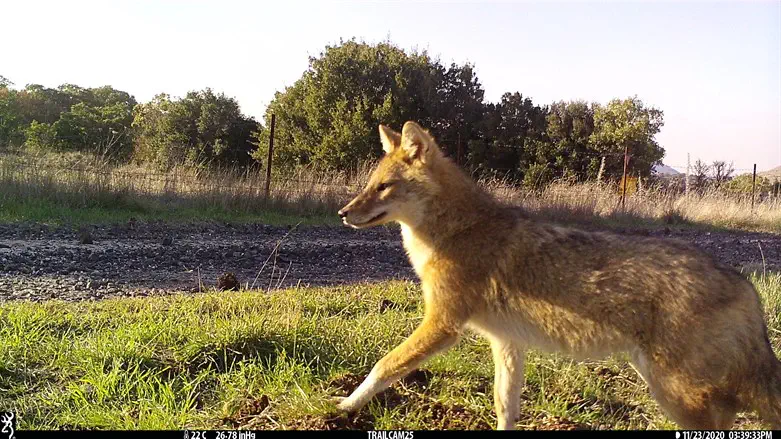
In Israel, golden jackals have been living in close proximity to human populations for many years. Jackals thrive in the urban habitats and are considered an "overabundant species." Anyone walking in Tel Aviv’s Yarkon Park or its surrounding neighborhoods has probably already seen golden jackals disappearing into the bushes or heard their howls after dark. Wildlife and municipal authorities ask the public not to approach the jackals or feed them, but a new study conducted in the Golan Heights reveals the possibility that the existing closeness between humans and jackals is leading the jackal to become a domestic animal in the future.
A novel Israeli study, the first of its kind in the world, was recently published in the scientific journal Scientific Reports discussing the question: Does living near humans lead to the domestication of jackals?
The findings of the research, conducted at the Shamir Institute for Research in Katzrin by PhD student Ayelet Barash from the School of Zoology at Tel Aviv University, under the guidance of Dr. Yaron Dekel, Scientific Director at the Shamir Institute for Research and the University of Haifa, and Professor Tamar Dayan, Chair of the Steinhardt Museum of Natural History and Tel Aviv University, indicate that living around the environment of humans could possibly be leading to the first stages of domestication in jackals, as probably happened in the domestication of dogs from wolves.
As part of the study, titled, "Possible origins and implications of atypical morphologies and domestication-like traits in wild golden jackals (Canis aureus)," a jackal displaying traits of a domesticated animal was initially suspected to be a hybrid of a jackal and a dog. However, comprehensive genetic and morphological analyses confirmed that it was actually a wild specimen. This is the first report of its kind in the literature – an animal that partially looks domesticated, but is not the result of hybridization, at least not in recent generations.
One of the first signs of domestication is a change in fur color. During a camera survey recently conducted in the Golan Heights by Shlomo Preiss-Bloom, also a PhD student at the School of Zoology at Tel Aviv University, five unusual jackals were discovered with exceptionally long fur or with white patches and an upright tail. Dr. Yossy Machluf from the Ministry of Education, Dr. Alon Barash from Bar Ilan University, and an Italian research group led by Dr. Romolo Caniglia from the Italian Institute for Environmental Protection ISPRA also participated in the study.
From one of the unusual-looking jackals, known in the study as "Jackie," DNA and skull samples were taken for examination. Jackie's DNA was compared to the DNA of other jackals and canid species, which revealed him to be 100% jackal, and not a hybrid with a dog. Jackie was also tested for relevant known coat color mutations and was found to carry none. A scan of the skull also revealed that it matched the skulls of other jackals.
One possibility is that Jackie might be the first case of incipient stages of self-domestication, after thousands of years since the last domestication process of a wild mammal. It should be noted that the land of Israel and the Golan region, situated in the heart of the Fertile Crescent, are the places in which the domestication of plants and mammals began. Jackie’s discovery might give us the possibility to witness in the present domestication in-vivo.
According to Dr. Yaron Dekel: "This is a scientific breakthrough, locally and internationally, that we have been working on for the past few years. A morphologically atypical jackal suspected as hybrid was found to be a jackal based on comprehensive genetic and morphologic analyses. This finding left us speechless. Is the process of domestication continuing after thousands of years? The ongoing genetic, evolutionary, and ecological research will enable us to learn more about this unique and novel phenomenon. We are only at the beginning of a fascinating journey."
According to Prof. Tamar Dayan, chair of the Steinhardt Museum of Natural History: "This unique discovery provides important scientific insight into the evolution of human-animal interactions , and sheds new light on the processes leading to animal domestication. The comparative research conducted as part of the study between the skulls and tissues of jackals preserved in the collections of the Natural History Museum, and the skull and DNA of 'Jackie,' is what allowed us to fully prove the physiological and genetic identity of 'Jackie' as a wild jackal. This is another great example of the importance of the museum's collections and the opportunity they give researchers to scientifically test their scientific hypotheses."
The number of jackals in the Golan Heights increases year by year and their population in Israel as a whole is thriving. These conditions are similar to the stages in the domestication of the dog more than 15,000 years ago: food waste was available around the evolving human environment that in turn attracted wolves that were less afraid of humans. These individuals gained more calories and gradually lost the characteristics necessary for hunting and camouflage, such as large muscle mass, large and well-developed jaws and a uniform color. This initiated the process of self-domestication and our dogs evolved.
At the request of the researcher, Ayelet Barash, if you have come across a jackal with unusual characteristics, such as multi-colored fur, particularly long fur or fur with white spots, please send photos and an exact location to ayelet.barash@gmail.com. In addition, anyone interested in promoting the research is asked to contact the Shamir Research Institute by email.

